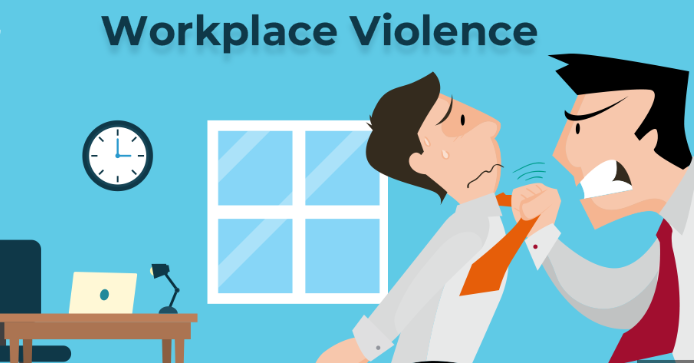Workplace violence has become a common concern for businesses and organizations worldwide. This is while much progress has been made in recent years in making professional settings free from harassment, discrimination, bullying, and other forms of incivility. However, aggression and violence—both physical and psychological—still exist in many places. If your workplace is not deemed safe by employees, this can lead to resignations, reputational damage, and financial losses.

The following are 7 ways you can prevent workplace violence in your organization:
1. Conduct a Risk Assessment
Before implementing a prevention strategy, it’s important to determine the specific types of violence that are most likely to occur in your workplace. You can do this through a risk assessment. During this process, you’ll want to identify the different types of risks that may lead to workplace violence, such as access to weapons, mental health issues and sexual harassment. You should also consider risks related to the nature of the work, the location and employees’ proximity to customers.
Next, you’ll want to examine your employees’ risk factors, including their personality traits, hours and overall ability to do their job. You can assess your employees’ risk factors by giving them a personality test or conducting an employee survey.
2. Establish Clear Responsibilities and Communication Channels
If an employee is experiencing a mental health issue, substance abuse or feels threatened by another individual at work, it’s important for him or her to know who to turn to for help. Many companies — especially those that require employees to work in isolated locations — may not have a human resources department nearby. Therefore, a mass notification platform, like Regroup, will help to establish clear responsibilities and communication channels among employees. This way, if an employee feels threatened by a peer, but is unsure how to report the issue, he or she will know who to speak with. This can be done through the creation of a “chain of command,” the organization of employees into different groups (e.g., production, administration, etc.) or the implementation of an easy-to-use, intuitive messaging and notification system.
3. Provide Employee Training and Support
If you’ve conducted an assessment, and determined that certain employees are at a higher risk of violence, you can provide them additional support and training. For example, if you’ve determined that certain employees are more prone to violence due to their personality traits, you can offer them additional coaching and support, such as access to employee assistance programs (EAPs) or mental health services.
If you’ve determined that certain employees are more prone to violence due to their profession, you can offer them additional training. Also, healthcare workers who are more prone to violence due to exposure to infectious diseases can be trained on how to properly use PPE (personal protective equipment).

4. Install Effective Surveillance Systems
Surveillance systems are an effective way to protect against workplace violence. You can use various types of surveillance, such as video cameras, alarms or a combination of both. You should install surveillance systems in locations where violence is most likely to occur, such as the break room, parking lot and entrances/exits. You can also install cameras in areas that employees are prohibited from entering.
You may also want to consider installing cameras in areas of the building that are out of view, like weapons storage areas that employees aren’t allowed to enter, or other secure places where you may want to install a surveillance system.
You can also consider installing facial recognition software. This technology can be used to identify employees, as well as detect when an unrecognized individual is on the premises.
5. Install Easy-to-Use Panic Button Technology
If you employ individuals who work in isolated locations, such as truck drivers or call center employees, you may want to employ panic button technology. You can do this by installing an easy-to-use button that employees can press in case of an emergency. You can either mount the button on the wall or provide your employees with a wearable device; such as a wristband, pendant or necklace.
When an employee presses the button, you’ll be able to receive an immediate audio or video feed of their location, and you’ll be able to contact emergency services. You can also install a two-way communication feature so that you can ask the employee what’s going on.
6. Implement Effective Lockdown Procedures
A lockdown protocol is typically implemented when suspicious persons are on scene. However, they can also be implemented in the case of violent or volatile employee behavior. . For instance, if an employee is demonstrating unpredictable or aggressive behavior, you can implement a lockdown procedure. You can also implement lockdown procedures by designating specific areas of the building that are off-limits to certain employees. You can further create a “blackout” policy, which is when you ask employees to close the blinds and turn off the lights when they know an employee they’re avoiding is coming to the building.
7. Offer Mental Health Awareness Training for Employees
Mental health issues are increasingly common in the workplace, and they’re often the root cause of violent incidents. Therefore, it’s important to offer mental health awareness training to employees. Mental health awareness training should include information about symptoms, how to seek professional help and how to deal with mental health issues at work.
Training should also encourage employees to reach out to Human Resources for assistance when they feel at risk. It’s critical to let employees know that if they’re struggling with mental health issues, they’re not alone. By offering this training, you can help prevent employees from feeling ashamed or embarrassed about their condition.
Ref: https://www.regroup.com/blog/7-ways-to-prevent-workplace-violence/










